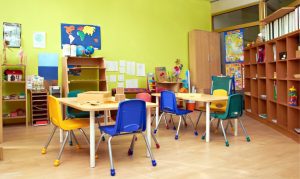- Transitional kindergarten (often referred to as TK) is California’s public school option for children who are not old enough for kindergarten to gain social and academic skills. Currently TK is available to children who turn 5 years old between September 2 and February 2. The program, however, is in expansion and by 2025-26, all 4-year-olds will be eligible for TK.
- At the same time, preschool programs with children as young as 3 are increasingly co-located at elementary schools and often under principal leadership.
- TK offers the opportunity to create the type of seamless experience young children need to maximize and sustain the benefits of preschool once they transition to kindergarten.
Elementary schools in California are expanding to offer programs to younger children. Transitional kindergarten (TK) is the state’s public school option for children who missed the cutoff for kindergarten entry by three months, giving older 4-year-olds a preK experience. By 2025, TK will be expanded to all 4-year-olds. And, increasingly, preschools with children as young as 3 years are connected to elementary schools, often under the principal’s leadership.
School districts’ new power over early childhood education (ECE) raises new questions as well as new opportunities. As district and school leaders make decisions about TK curriculum, assessment, instruction, and teacher professional development, they are asking whether TK is more like preschool or kindergarten. Or is TK a completely new grade level that needs to be treated differently from both preschool and kindergarten?
TK Teachers Are Also Preschool and Kindergarten Teachers
A better way to view TK is as the connective tissue between preschool and kindergarten. Educators naturally think in terms of grade levels corresponding to age. But the reality is that a group of similar-aged children in a particular grade typically possess a range of skill levels that transcend grades. A first-grade teacher, for example, is likely to be teaching some children who have not met the kindergarten standards and some children who mastered the standards before they entered her classroom. If she adjusts instruction, she is effectively teaching kindergarten through second grade. Likewise, a TK teacher is functionally a preschool through kindergarten teacher, given the likely range of TK children’s skills.
Creating a Preschool-TK-Kindergarten Educational Continuum
TK offers the perfect opportunity to overcome the limits of grade-level thinking by positioning it as the middle of a learning journey children take from preschool through kindergarten. This blog highlights effective policies and practices that support TK implementation aimed at creating a preschool-TK-kindergarten educational continuum. The recommendations have the added value of helping sustain the benefits of preschool and TK. Many studies have shown that the advantages of preschool attendance are sometimes eroded over the first few years of elementary school, referred to as the “fade-out effect” [1]. This reduction in benefits is caused in part by the disconnect between preschool and the early elementary grades [2]. TK offers an opportunity to achieve the kind of seamless experience young children need to maximize and sustain the benefits of ECE.
Curriculum and Instruction
The ideal ECE curriculum spans preschool through kindergarten, with the kindergarten curriculum beginning where the preschool curriculum ended. Where in the curriculum teachers begin instruction depends on their students’ skills, and teachers may not begin exactly in the same place for all children.
It is not easy to find commercially available preschool and kindergarten curricula that are so well aligned. Even if not from the same publisher, curricula should be chosen to make sure that kindergarten instruction extends what children learned prior to kindergarten. Research shows that kindergarten teachers, and especially those in schools serving families from under-resourced neighborhoods, tend to spend a significant amount of time teaching skills that children mastered before they entered their classrooms [3, 4]. These findings suggest the importance of curricula that build on—rather than overlap with—the preschool curriculum. TK that repeats what children learned in preschool will be a year wasted, just as kindergarten that does not extend what children learned in TK means lost learning opportunities. Curricula that are continuous across preschool, TK, and kindergarten make it easier for teachers to ensure continued learning, no matter the child’s starting point.
The nature of instruction that the curriculum promotes is also important. Opportunities to develop foundational subject matter skills are important in preschool, especially given the significant achievement gap that exists in California at kindergarten entry [5]. Also, children do not enter kindergarten, or even first or second grade, with self-regulation and social skills fully developed. Young children throughout the entire preschool-TK-kindergarten span benefit from free play as well as guided, playful instruction.
Research on both math and literacy teaching suggests that effective instructional practices in preschool and the early grades are the same, although specific strategies and certainly the level of difficulty change. Curricula do not necessarily dictate instruction, but most imply specific approaches to instruction. Therefore, continuity in effective instructional approaches across the grades should be key considerations in selecting curricula.
Effective Student Assessment Tools
If teachers need to build on what children know, they need to know what children know. Effective teachers notice and assess children’s knowledge throughout the day and adjust instruction accordingly. Most useful for this purpose are formative assessments that gauge how well children have mastered the skills they have just been working on. Teachers can use this information to make judgments about next steps for individuals, groups of children, or the whole class.
Broad assessments linked to standards are useful to district and school leaders. They enable them to determine the impact of policies and practices and make judgments about what kind of support teachers need. To effectively track children’s progress from preschool through kindergarten, the assessment instrument needs to be continuous, allowing a child to demonstrate skills anywhere on the continuum. Akin to the notion of a continuous curriculum that begins at different points based on student skills, children in TK can enter the assessment continuum at various levels. Using an assessment that includes items aligned with both the preschool and the kindergarten standards provides a more accurate picture of the progress of children in TK who may be working on skills at any point in this continuum.
Professional Development for Teachers and School Leaders
To understand where students are in their learning journey, teachers in preschool through kindergarten need to know the standards, curriculum, and teaching practices from the level before and after the level they teach. These goals can be achieved by providing cross-grade professional development sessions, by having the same coach work with teachers across grades, and by giving teachers opportunities to meet and learn from one another. Researchers who have studied the effects of collective professional development find that it supports the culture and helps sustain the new practices teachers learn [6].
Creating an effective and continuous ECE experience requires the involvement of school leaders. Most elementary school principals do not have an ECE background, and many feel ill-equipped to support instruction. There is evidence that ECE professional development for school leaders can reverse principals’ reluctance to play an instructional leadership role and position them to better support teachers in preschool through kindergarten classes.
Conclusion
TK instruction is the link between preschool through kindergarten, helping students advance their learning from wherever they start. TK teachers should have the option of using the preschool or kindergarten curriculum from the beginning and throughout the year, and access to the assessment tools they need to make developmentally appropriate instructional decisions. Preschool, TK, and kindergarten teachers need to know the full range of standards and curriculum and have opportunities to collaborate. School leaders need to be knowledgeable of effective ECE practices to support continuity efforts.
[1] Puma, M., Bell, S., Cook, R., Heid, C., Broene, P., Jenkins, F., Mashburn, A., & Downer, J. (2012). Third Grade Follow-up to the Head Start Impact Study Final Report, OPRE Report # 2012-45, Washington, DC: Office of Planning, Research and Evaluation, Administration for Children and Families, U.S. Department of Health and Human Services.
[2] Stipek, D., Clements, D., Coburn, C., Franke, M., & Farran, D. (2017). PK–3: What does it mean for instruction? Social Policy Report, 30(2).
[3] Cohen-Vogel, L., Little, M., Jang, W., Burchinal, M., & Bratsch-Hines, M. (2021). A missed opportunity? Instructional content redundancy in Pre-K and kindergarten. AERA Open, 7, 23328584211006163.
[4] Engel, M., Claessens, A., & Finch, M. (2013). Teaching students what they already know. The (mis)alignment between mathematics instructional content and student knowledge in kindergarten. Educational Evaluation and Policy Analysis, 35(2), 157–178.
[5] Reardon, S. (2013). The widening income achievement gap. Educational Leadership, 70 (8), 10-16.
Stipek, D., Borsato, G. & Coburn, C. (2002). Bringing Early Childhood Education into Elementary School: School Leaders are Key. Development and Research in Education (DREME). dreme.stanford.edu
[6] Burchinal, M., Hyson, M., & Zaslow, M. (2008). Competencies and credentials for early childhood educators: What do we know and what do we need to know? National Head Start Association Dialog Briefs 11 (1).



